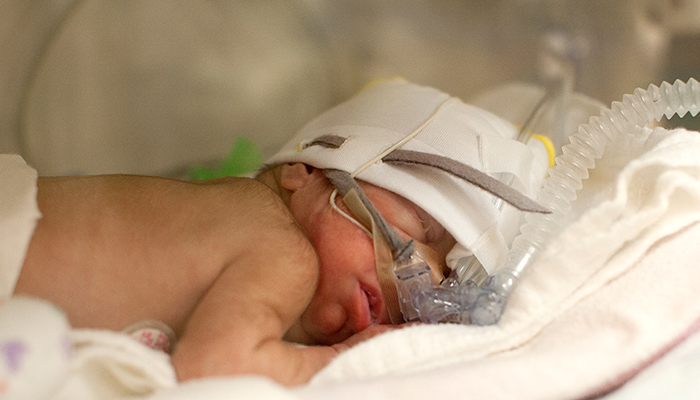HOW CAN WE HELP YOU? Call 1-800-TRY-CHOP
In This Section
Is Positive Airway Pressure Effective for Infants With OSA?

Researchers previously lacked objective data on the effectiveness and tolerance of PAP for infants with obstructive sleep apnea.
limjr [at] chop.edu (By Jillian Rose Lim)
The Findings
Positive airway pressure, or PAP, is as effective and well-tolerated treatment for infants with obstructive sleep apnea (OSA), according to research from scientists in our Division of Pulmonary and Sleep Medicine. Clinicians should consider the treatment – which involves wearing a mask that introduces air into the airways during sleep – for infants, as they would for older school-aged children.
Why it Matters
Clinicians are increasingly recognizing OSA in infants, particularly those with airway conditions and neuromuscular abnormalities. The condition has been associated with reduced quality of life, failure to thrive, developmental delays, and sudden death in this age group. But while PAP has been shown to improve sleepiness and quality of life in school-aged children with OSA, until now researchers lacked objective data on the effectiveness of the therapy for infants. With objective data and more knowledge about the potential barriers to OSA use and adherence in infants, researchers can improve the guidelines for PAP use in this age group.
Who Conducted the Study
Christopher Cielo, DO, attending pulmonologist at CHOP, conducted the study, along with CHOP colleagues Alyssa Ciampaglia; Melissa Xanthapoulos, PhD; Suzanne Beck, MD; Ignacio Tapia, MD; and Patricia Hernandez, a medical student at the University of Pennsylvania’s Perelman School of Medicine.
How They Did It
In a retrospective study, the team compared PAP data from infants younger than 6 months with children 5 to 10- years-old with OSA. This data included baseline and titration polysomnography data, PAP adherence data, and parent-reported barriers to adherence.
Quick Thoughts
"This study challenged the belief held by many that PAP is less effective at treating obstructive sleep apnea in infants than older children and adults, where PAP is considered the standard of care,” Dr. Cielo said. “OSA is increasingly identified in high-risk infants, and our data provides support for PAP as an effective treatment for these complex patients.”
What’s Next
"Our interdisciplinary team continues to work with colleagues and collaborators across CHOP, including Neonatology, Plastic Surgery and Otolaryngology, Respiratory Therapy, and other subspecialists to improve the evaluation and management of OSA in infants,” Dr. Cielo said. “Ongoing studies include utilizing 3D printing to develop better PAP interfaces for infants and conducting interviews with parents of infants treated with PAP to understand the lived experience and challenges for families.”
Where the Study Was Published
The study was published in the journal CHEST.
Where to Learn More
Learn more about Dr. Cielo’s research.


